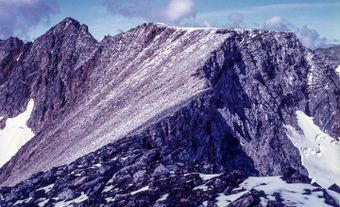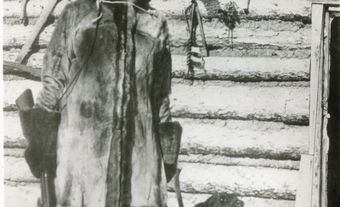Mary Schäffer Warren (née Mary Townsend Sharpless), naturalist, writer, photographer, surveyor (born 4 October 1861 in West Chester, Pennsylvania; died 23 January 1939 in Banff, AB). Schäffer Warren is best known for being the first non-Indigenous person to explore Maligne Lake in the Canadian Rockies. She was one of the first non-Indigenous women to travel through much of what is now Banff and Jasper national parks. Although she had no experience as a surveyor, the Geological Survey of Canada asked her to survey Maligne Lake in 1911. As a result, Schäffer Warren is responsible for naming several of the geographic features surrounding the lake (see also Ten Mountains in Canada Named After Women). Through writing and lantern-slide presentations of her hand-painted photographs, she encouraged tourism to the Rockies.

Early Life
Mary Schäffer Warren was born into an upper-middle-class Quaker family in West Chester, Pennsylvania on 4 October 1861. As Quakers, the Sharpless family valued education. Schäffer Warren was educated in natural history, math, literature and painting. She developed a particular interest in natural history, a pursuit her father encouraged. He took her into nature and arranged for Schäffer Warren to study botanical painting with an artist. As a teenager, Schäffer Warren travelled to the American West and along the Alaskan coast.
Beginnings in the Canadian Rockies
In 1889, Mary Schäffer Warren married Dr. Charles Schäffer, who was 23 years her senior. Charles was a medical doctor and amateur botanist, and they shared an interest in natural science. That year, the couple embarked on their first trip to the Canadian Rockies on the recently opened Canadian Pacific Railway. They lived in Philadelphia and beginning in 1891, visited the Rockies every summer. During these trips, Charles conducted botanical research and Schäffer Warren assisted by pressing, sketching, painting and photographing wildflowers. This work earned her entrance into the Philadelphia Academy of Natural Sciences.
Schäffer Warren lost both her parents and husband in 1903. Following their deaths, she returned to the Rockies to finish Charles’ botanical research. She published the work in a book, Alpine Flora of the Canadian Rockies, for which she had contributed the illustrations.
Continuing Travels in the Rockies
Mary Schäffer Warren’s travels in the Rockies were much different after the loss of her husband. She spent less time travelling by train and staying in hotels and more time on horseback and in camps. She began travelling with other American women, and soon found a like-minded travel companion in Mary “Mollie” Adams. They hired guides for their trips, one of whom was William “Billy” Warren, an English veteran of the South African War. He later become Schäffer Warren’s second husband.
In these years, her confidence as a mountaineer and in exploring the wilderness of the Rockies grew. Trading her skirts for breeches, Schäffer Warren embraced life in the wilderness, despite society’s expectations for a woman from her background.

Maligne Lake
In 1907, Mary Schäffer Warren and Mollie Adams, along with their guides, embarked on an expedition to the headwaters of the Saskatchewan and Athabasca rivers. Schäffer Warren had heard about a “hidden” lake north of Brazeau Lake, in what is now Jasper National Park. Several decades earlier, in 1875, a Canadian Pacific Railway surveyor named Henry Macleod had spotted the lake in question. Deeming its location a poor route for the railway, Macleod moved on without further exploration. However, the lake was known to the Stoney-Nakoda peoples as Chaba Imne (Beaver Lake), and they, along with the Cree, had used the area for beaver trapping.
Sampson Beaver, a Stoney-Nakoda man and friend of Schäffer Warren’s, sketched a rough map of the lake from his memory of visiting as a child. While they were unsuccessful in locating the lake during their 1907 trip, they returned the next year and were able to find it. Schäffer Warren is widely recognized as the first non-Indigenous person to explore the lake, although she credited her guides with making the trip possible.
Their party built a raft and spent a few days exploring the lake. Schäffer Warren claimed: “Lake Louise is a pearl; Lake Maligne is a whole string of pearls.” She wrote about their experience searching for and finding the lake in a book, Old Indian Trails of the Canadian Rockies, published in 1911.
Surveying Maligne Lake
Dr. D.B. Dowling of the Geological Survey of Canada asked Mary Schäffer Warren to survey Maligne Lake. This was an unusual choice as it went against a government policy restricting women from even accompanying surveying parties, let alone leading one. She was likely chosen because of her reputation as a prominent explorer and mountaineer, and for the notoriety she had gained from her 1908 trip to the lake. While initially hesitant to take the offer because she did not have any experience or training as a surveyor, she eventually accepted and surveyed the lake in 1911.
Schäffer Warren named several of the geographic features around the lake after her fellow travellers and friends and the names were accepted by the Geographical Board of Canada. Some of the names included Mount Unwin for one of her guides, Sidney Unwin; Mount Warren for another of her guides (and later husband), Billy Warren; Mount Mary Vaux for her mountaineer friend Mary Vaux Walcott; and Samson Peak for Sampson Beaver, the Stoney Nakoda man who drew the map to the lake. She named Maligne Lake after the Maligne River flowing out of the lake, as it was the standard to name features in the same area by the same name.
Later Life in Banff
In 1912, Mary Schäffer Warren had a house built in Banff, where she lived until her death. The house, named Tarry-a-while, is now a National Historic Place. In 1915, she married William Warren, who had been a guide on many of her trips and was almost twenty years her junior. After their marriage, the couple continued travelling through the Rockies, although these were shorter journeys due to her failing health. They also travelled through Canada, the United States, Mexico, Central America and the Caribbean.
Schäffer Warren encouraged tourism to the Rockies, writing about her experiences for Canadian and American publications and promotional brochures. She presented lantern-slide shows showcasing the hand-painted photographs she had taken during her journeys.
Schäffer Warren joined the Imperial Order of the Daughters of the Empire, a women’s charitable organization. She was also involved with several other groups, including the Alpine Club of Canada, the National Geographic Society and the Royal Geographical Society.
She passed away from pneumonia on 23 January 1939 in Banff.
Mount Schaffer and Schaffer Lake in Yoho National Park are named in honour of Mary and Charles Schäffer.

 Share on Facebook
Share on Facebook Share on X
Share on X Share by Email
Share by Email Share on Google Classroom
Share on Google Classroom



